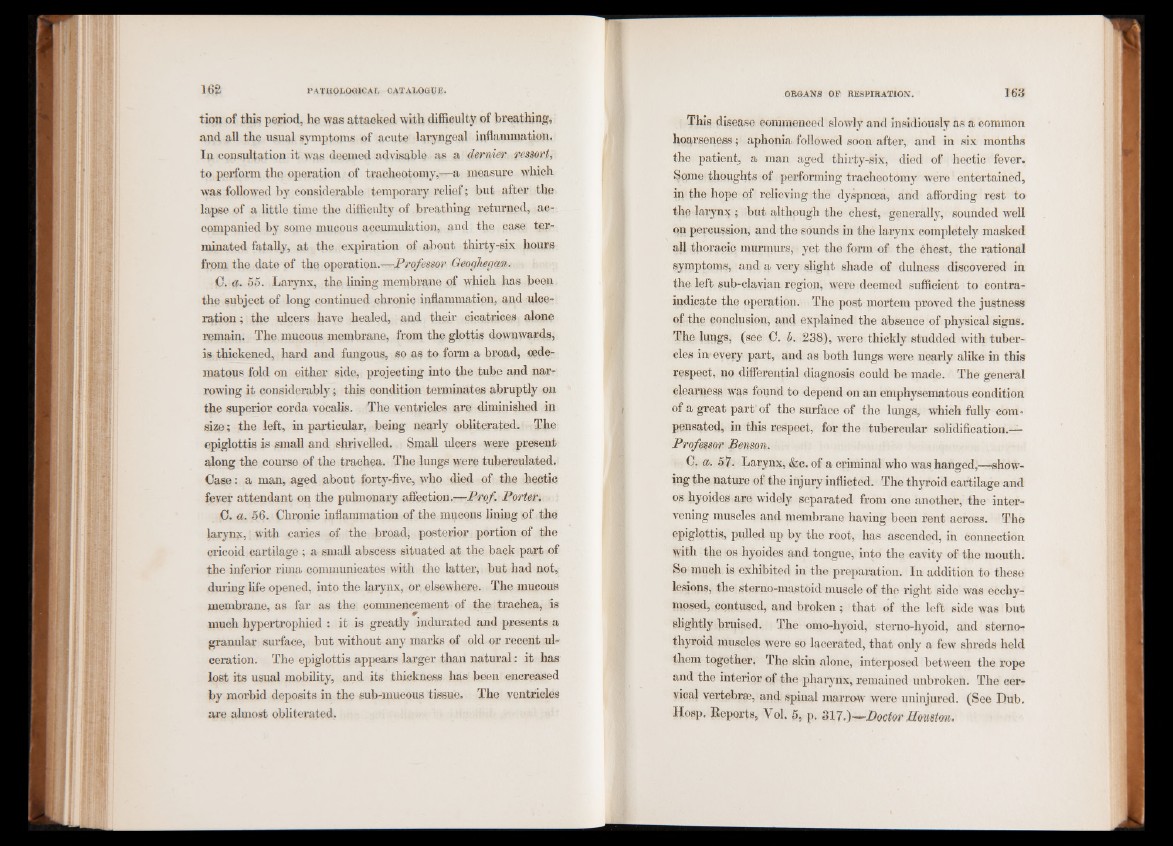
tion of this period, he was attacked with difficulty of breathing,
and all the usual symptoms of acute laryngeal inflammation.
In consultation it was deemed advisable as a dernier ressort,
to perform the operation of tracheotomy,-—a measure which
was followed by considerable temporary relief; but after the
lapse of a little time the difficulty of breathing returned, accompanied
by some mucous accumulation, and the case terminated
fatally, at the expiration of about thirty-six hours
from the date of the operation.—Professor Geoghegan.
C. a. 55. Larynx, the lining membrane of which has been
the subject of long continued chronic inflammation, and ulceration
; the ulcers have healed, and their cicatrices alone
remain. The mucous membrane, from the glottis downwards,
is thickened, hard and fungous, so as to form a broad, oede-
matous fold on either side, projecting into the tube and narrowing
it considerably; this condition terminates abruptly on
the superior corda vocalis. The ventricles are diminished in
size; the left, in particular, being nearly obliterated. The
epiglottis is small and shrivelled. Small ulcers were present
along the course of the trachea. The lungs were tubereulated.
Case: a man, aged about forty-five, who died of the hectic
fever attendant on the pulmonary affection.—Prof. Porter.
C. a. 56. Chronic inflammation of the mucous lining of the
larynx, with caries of the broad, posterior portion of the
cricoid cartilage ; a small abscess situated at the back part of
the inferior rima communicates with the latter, but had not,
during life opened, into the larynx, or elsewhere. The mucous
membrane, as far as the commencement of the trachea, is 0 much hypertrophied : it is greatly indurated and presents a
granular surface, but without any marks of old or recent ulceration.
The epiglottis appears larger than natural: it has
lost its usual mobility, and its thickness has been encreased
by morbid deposits in the sub-mucous tissue. The ventricles
are almost obliterated.
This disease commenced slowly and insidiously as a common
hoarseness; aphonia followed soon after, and in six months
the patient, a man aged thirty-six, died of hectic fever.
Some thoughts of performing tracheotomy were entertained,
in the hope of relieving the dyspnoea, and affording rest to
the larynx ; but although the chest, generally, sounded well
on percussion, and the sounds in the larynx completely masked
all thoracic murmurs, yet the form of the chest, the rational
symptoms, and a very slight shade of dulness discovered in
the left sub-clavian region, were deemed sufficient to contraindicate
the operation. The post mortem proved the justness
of the conclusion, and explained the absence of physical signs.
The lungs, (see 0. 1. 238), were thickly studded with tubercles
in every part, and as both lungs were nearly alike in this
respect, no differential diagnosis could be made. The general
clearness was found to depend on an emphysematous condition
of a great part'of the surface of the lungs, which fully compensated,
in this respect, for the tubercular solidification.—
Professor Benson.
G. a. 57. Larynx, &c. of a criminal who was hanged,—showing
the nature of the injury inflicted. The thyroid cartilage and
os hyoides are widely separated from one another, the intervening
muscles and membrane having been rent across. The
epiglottis, pulled up by the root, has ascended, in connection
with the os hyoides and tongue, into the cavity of the mouth.
So much is exhibited in the preparation. In addition to these
lesions, the sterno-ma.stoid muscle of the right side was eccliy-
mosed, contused, and broken ; that of the left side was but
slightly bruised. The omo-hyoid, sterno-hyoid, and sternothyroid
muscles were so lacerated, that only a few shreds held
them together. The skin alone, interposed between the rope
and the interior of the pharynx, remained unbroken. The cervical
vertebrae, and spinal marrow were uninjured. (See Dub.
Hosp. Reports, Yol. 5, p. 317.)—Doctor Houston.